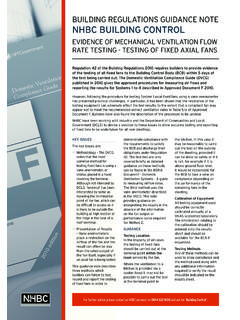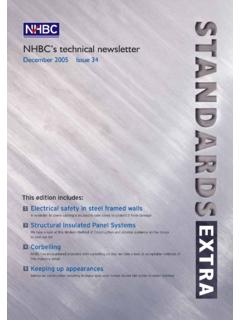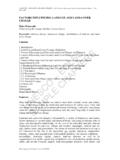Transcription of HARDCORE FOR SUPPORTING GROUND FLOORS OF …
1 DIgest DG 522 Part 1. HARDCORE FOR SUPPORTING . GROUND FLOORS OF BUILDINGS. Part 1: Selecting and specifying materials Ian Longworth, BRE Associate This Digest provides guidance to engineers and builders on selecting and placing material for use as HARDCORE in building construction. It takes account of recent standards for specifying aggregate materials for use as HARDCORE , ensuring that the material is both physically stable and chemically inert. In Part 1 candidate materials are reviewed, including recycled and secondary materials that are currently being promoted for use in construction as a sustainable option. Simplified recommendations for common situations are given Figure 1: HARDCORE within the foundation of a building.
2 To in Section 6. the right the HARDCORE is being blinded with sand to await the Part 2 deals with placing and compacting laying of a damp-proof membrane and insulation. HARDCORE material. It also reviews some unsuitable materials that were used for HARDCORE before the Some of the materials and placing procedures used mid-1970s, both as a cautionary note for current in the past have not met these requirements and there specifiers and as a guide for professionals dealing has been consequent damage to buildings. The principal with a legacy of unstable HARDCORE problems in occurrences have been chemical attack by HARDCORE existing buildings. materials on concrete, settlement due to poor compaction, This Digest replaces Digest 276, which is now and swelling or consolidation due to changes in water withdrawn.
3 Content and/or chemical instability. Because of these past failures, Approved Document C of The Building Regulations 2010 (England and Wales)[1] includes, at Clause (a), the requirement for a well-compacted 1 WHAT IS HARDCORE ? HARDCORE bed, no greater than 600 mm deep, of clean, HARDCORE ' is the construction term used to denote broken brick or similar inert material, free from materials engineered' infill material that is placed within the confines including water-soluble sulfates in quantities that could of a building foundation (after removal of any unsuitable damage the concrete'. The significance of these various GROUND layers) in order to support a GROUND -bearing floor characteristics is discussed in Section 3 (see the Appendix slab (Figure 1).)
4 Typical of older buildings, the term also refers for alternative text for other UK countries). to material used to support an oversite' concrete slab, which In civil engineering terminology, material used for carries sleeper walls beneath a suspended timber floor . As HARDCORE may be termed, according to context, an such, the HARDCORE must provide a firm, dry, level base, at an unbound material' or an unbound mixture' made up appropriate height. Materials for HARDCORE should be granular of aggregates. Aggregate' here is a general term for any and drain and compact readily, as well as being chemically granular material used in construction, while unbound'. inert and not affected by water.
5 They should also be well indicates that the material has no binding agent such as compacted in layers of appropriate thickness. asphalt or cement. 2 HARDCORE FOR SUPPORTING GROUND FLOORS OF BUILDINGS Dg 522 PART 1. This Digest describes materials for HARDCORE that The SUPPORTING Approved Document explains the ways conform to commonly used specifications and are in which the suitability of material for use for a particular examples of best practice. Their inclusion is not purpose may be assessed. For HARDCORE these ways include: meant to exclude the use of materials specified by conformity with a British or European Standard;. any alternative procedure that results in material that certification by an independent certification is demonstrably fit for purpose for use as HARDCORE in scheme, eg one accredited to the United Kingdom particular situations.
6 Accreditation Service (UKAS);. tests and calculations; and past experience, eg satisfactory performance as in a building in use. 2 LIMITATIONS ON THE USE OF HARDCORE . The use of HARDCORE to support FLOORS of buildings is Material for use as HARDCORE in buildings needs to provide appropriate only where the underlying GROUND is stable. stable and adequately strong support for the GROUND floor The use of HARDCORE is not recommended where: slab and any superimposed loads during the working life the existing GROUND contains vegetative soil or organic of the building. Usually it will not be possible to rectify matter including tree roots this layer should be any post-construction problem originating in the HARDCORE removed to leave an even bearing surface; without major disruption for building occupants and high the existing GROUND contains non-engineered fill; remedial costs.
7 The existing GROUND comprises a clay soil that may For this reason, the selection of material for HARDCORE shrink or swell significantly owing to changes in must be undertaken with due care. In this context, it is moisture content, such as that associated with the relevant to note that material intended for the subbase growth or removal of nearby trees; of highways is often used as HARDCORE in buildings. the existing GROUND comprises soft natural GROUND While such subbase material generally does have all the that may consolidate or compress significantly under properties needed for HARDCORE , the Highways Agency superimposed load; or specifications for this material allow for it to be sometimes a HARDCORE thickness of greater than 600 mm would be less dimensionally stable and more chemically active required at any location for residential buildings.
8 Than is appropriate for use within the rigid confines of a building foundation and floor slab. Such marginal physical Additionally, the advice of an appropriately qualified and chemical stability has been increasingly common in engineer should be sought where: recent years, during which the specification for subbase for non-residential buildings the thickness of HARDCORE has been extended to include greater use of recycled and required to support a floor needs to be greater than secondary materials of marginal quality. 600 mm at any location within the foundations; or The essential characteristics of material to be used as there is a potential for any upward groundwater flow HARDCORE are that it is: into HARDCORE .
9 Straightforward to handle, place and compact within the confines of a building foundation;. In the case of low-rise residential buildings, where any of capable of SUPPORTING the floor and superimposed the foregoing limiting GROUND conditions are encountered loads without compression;. the use of suspended concrete FLOORS is widely dimensionally stable after placement, ie it must not be recommended. prone to expansion or compression;. physically unaffected by change in water content;. biologically inert, ie free from organic matter that might decay or sustain fungal growth;. 3 SELECTION OF APPROPRIATE MATERIAL FOR chemically inert, ie free of any substance that might HARDCORE react within the HARDCORE material causing volume A framework for material selection change, or that might attack adjacent construction A good starting point for selecting materials for HARDCORE elements; and is the Approved Document to support Regulation 7 radioactively inert, eg not an emitter of radon gas.
10 Of The Building Regulations 2010 (England and Wales)[2]. This is a document that is often overlooked One ideal material that will usually satisfy the above is clean, since it is not labelled with a letter, unlike the other well-graded, granular aggregate comprising crushed hard Approved Documents. Building Regulation 7 states the rock (the rock should be crushed so that it passes through requirement' that: the holes of a 63 mm test sieve, and then sorted so that the Building work shall be carried out: product has a fairly even gradation of particle sizes such that a. with adequate and proper materials which: smaller particles will readily fill voids that would otherwise i.)










